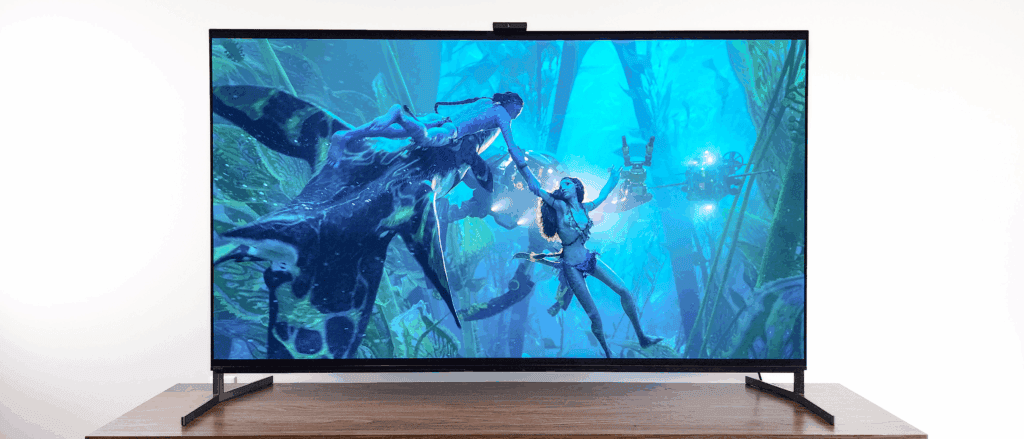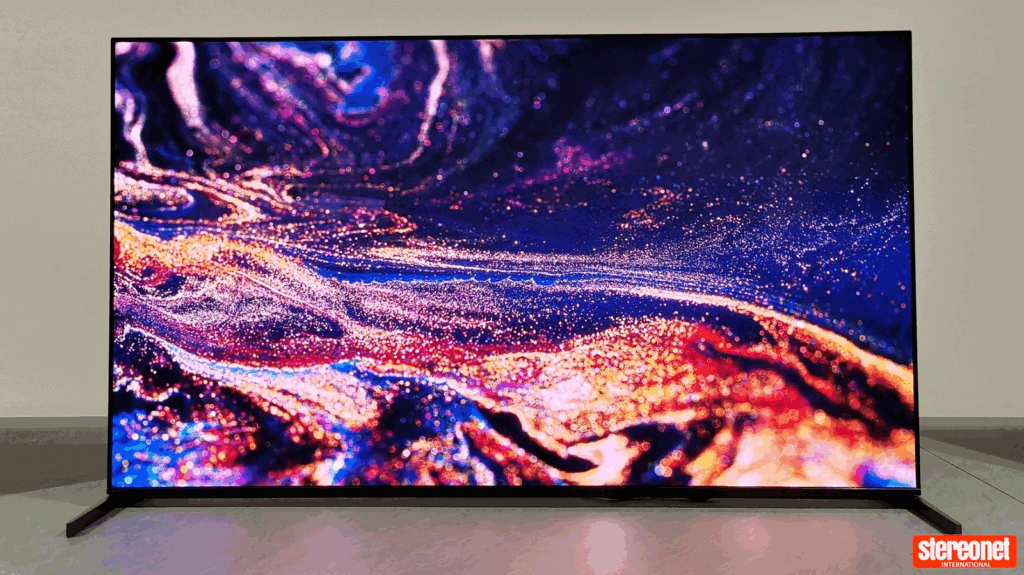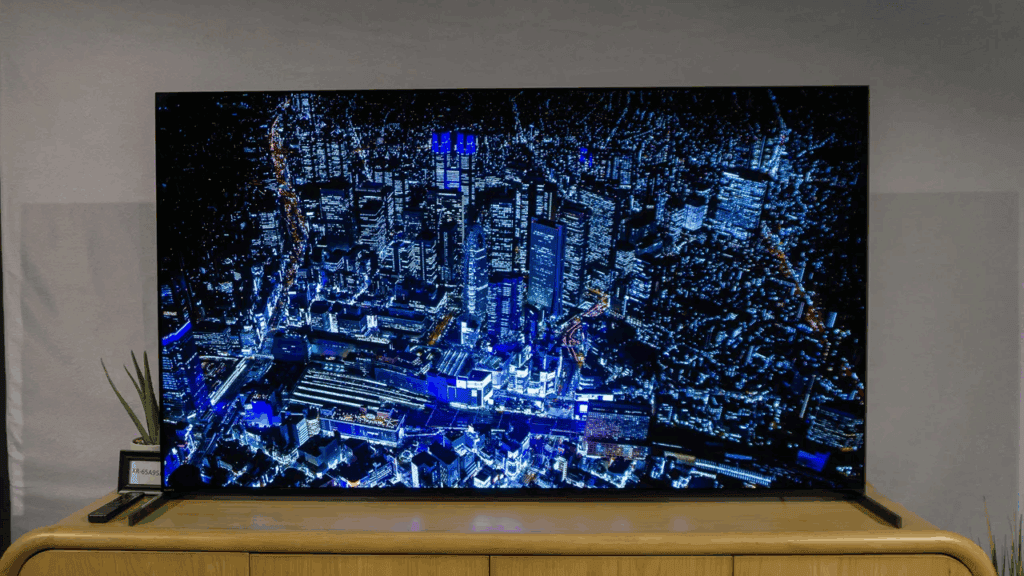The Sony A95L has earned plenty of praise since its launch. As a high-end QD-OLED television, it boasts vibrant colors, deep blacks, and cutting-edge display technology. Sony markets it as a flagship experience, and on paper, it ticks all the boxes: 4K at 120Hz, HDMI 2.1, Google TV, and a next-gen QD-OLED panel. But peel back the marketing gloss, and some very real drawbacks come into focus. If you’re shopping for a premium TV, especially in 2025’s crowded market, you should know where the A95L falls short, and it does, in several meaningful ways.
Table of Contents
- 1 It’s Expensive, Really Expensive
- 2 Limited HDMI 2.1 Ports Restrict Flexibility
- 3 Google TV Interface: Buggy and Sluggish
- 4 Picture Quality Has Asterisks
- 5 The Design Isn’t User-Friendly
- 6 Gaming: Some Sacrifices Made
- 7 Audio Still Needs Help
- 8 The Bravia Cam: Unnecessary and Unwanted?
- 9 Internet Speeds Bottlenecked by LAN Port
- 10 Final Thoughts: Great Tech, Flawed Package
It’s Expensive, Really Expensive
Let’s start with the obvious: the Sony A95L is one of the priciest TVs in its class. While you can expect to pay top dollar for flagship performance, the A95L overshoots even that bar. In many regions, it’s significantly more expensive than its direct rivals, such as the LG G3 or the Samsung S95C. Depending on size and retailer, it can be hundreds of dollars more for comparable specs.
For owners of the previous-generation A95K, the upgrade may not be compelling enough to justify the cost. The performance bump is marginal, and some reviewers have gone so far as to call the upgrade “not worth the effort.”
In practical terms, this means you’re paying more and getting very little extra. Add to that the cost of accessories like a proper sound system (more on that later), and you’re staring at a steep investment that doesn’t clearly outperform cheaper alternatives.
Limited HDMI 2.1 Ports Restrict Flexibility

Despite being marketed for gamers and home theater enthusiasts, the A95L only offers two HDMI 2.1 ports that support 4K at 120Hz. That in itself isn’t great, but here’s the real kicker: one of those is also the eARC port, typically used for connecting external audio systems.
So if you’re using a soundbar or AV receiver through eARC, you’re left with just one usable HDMI 2.1 port for devices like a PlayStation 5, Xbox Series X, or high-end gaming PC. This limitation can force users into buying an HDMI switcher, adding to both cost and clutter.
For a TV in this price range and era, this bottleneck feels like a serious misstep. Competitors offer more HDMI 2.1 ports, better accommodating multi-device setups without compromises.
Google TV Interface: Buggy and Sluggish
Sony continues to lean on Google TV, and unfortunately, the experience is far from seamless. Users have reported lag when switching inputs, slow boot times, and interface hiccups. That’s compounded by a healthy dose of unskippable ads, cluttered menus, and recommended content that’s often irrelevant (hello, Tuby).
The onboard processor, likely the same as the one in the A95K, shows its age. Menu transitions aren’t buttery smooth, and app loading times can feel sluggish for a TV at this tier. Even more frustrating, the Sony-specific settings menus have been redesigned, confusing long-time users and adding learning curve where there should be simplicity.
Reviewers also flagged software bugs tied to the new MediaTek Pentonic 1000 chipset. These include:
- HDR mode not activating automatically
- Calibration presets not displaying correctly in Calman for Bravia
- Periodic lag in the menu system
- Motion issues on startup
- Lack of key UK streaming apps (e.g., BBC iPlayer)
All told, the interface feels less refined than it should be.
Picture Quality Has Asterisks

Yes, the picture is gorgeous. But it’s not flawless.
For one, Dolby Vision content has quirks. Several users reported tone-mapping issues in dark scenes, shadows can appear brighter than they should, which flattens depth and detail. Others have noticed a pink or green hue in certain scenes, and an unsettling green flash when switching to Dolby Vision over HDMI.
Dark uniformity isn’t perfect either. Some panels show faint vertical bands in dark scenes, a slight step back from the A95K. And a recurring issue with QD-OLEDs, including the A95L, is dark color desaturation, where shadow tones lose richness.
Upscaling performance introduces its own headache. Even at neutral sharpness settings, the TV applies subtle edge enhancement, which can result in halos around objects. Purists looking for a clean, untouched image might find this irksome.
Other image concerns include:
- Auto Dimming: Static content triggers logo detection dimming in SDR mode. Sports tickers or game HUDs can cause the whole screen to dim.
- Color Accuracy: HDR color is just okay out of the box, and white balance skews blue unless calibrated.
- Gradient Handling: Slight banding is visible in grays, which is minor but present.
The Design Isn’t User-Friendly
For all its premium sheen, the A95L’s physical design raises several usability issues.
First, the stand. The included feet don’t snap into place as securely as you’d expect. Positioned at the TV’s far ends, they also require a table or platform as wide as the entire screen, a problem if you’re short on space.
Then there’s the VESA mount placement. The mounting holes sit unusually low on the chassis, meaning your wall mount may need to be adjusted higher if you’re swapping out a previous set.
Other small design oversights include:
- A non-standard power cable (not the typical C13 type)
- A thin film around the screen edges that’s hard to remove cleanly
- Grayish screen appearance when powered off (due to the lack of a polarizer)
- Mild purple reflection haze in bright rooms
These issues won’t affect performance directly but chip away at the premium experience Sony is aiming for.
Gaming: Some Sacrifices Made

The A95L is marketed as a gaming-ready display, but gamers may want to look twice.
While input lag is low, it’s still slightly higher than that of the LG G3 and Samsung S95C. For most people, that difference is minor, but competitive gamers might feel it.
More importantly, it lacks FreeSync support. If you’re a PC gamer with an AMD graphics card, you’re out of luck unless it supports HDMI Forum VRR or G-Sync.
Other issues include:
- No HDR10+ support, which some games and content use
- Brightness drop in game mode, reducing the wow factor
- Subpixel arrangement makes PC text look less sharp, with some color fringing
All of these add up to a less-than-ideal experience if gaming is your priority.
Audio Still Needs Help
Sony talks up the A95L’s Acoustic Surface Audio+, but the results are mixed.
The built-in speakers are fine for casual viewing, but they lack low-end punch. Bass is light, and at higher volumes, distortion creeps in. The center channel is functional but falls short for dialogue-heavy content unless you’re directly in front of the screen.
For any kind of immersive experience, an external sound system is essential. That, however, reintroduces the HDMI 2.1 port limitation due to the reliance on the eARC port.
Latency is another issue. There’s around 300ms of audio delay with 24fps content, particularly Dolby Atmos, which leads to lip-sync mismatch. Worse, there’s no built-in setting to manually adjust audio sync for internal speakers.
To top it off, the A95L does not support DTS audio formats, limiting compatibility with Blu-rays and legacy media libraries.
The Bravia Cam: Unnecessary and Unwanted?

The Bravia Cam is included, but most users won’t need it, and some may find it invasive. While it offers features like auto audio adjustment and ambient light detection, those were already built into previous models without needing a camera.
Gesture controls are awkward at best, gimmicky at worst. Few users will find themselves waving at their TV to pause Netflix. The screen dimming based on viewer proximity is too subtle to be meaningful.
Privacy is another concern. While there is a physical shutter, it doesn’t disable the built-in microphones, and Sony has offered little transparency around data collection. For a TV that costs this much, the camera feels like a tacked-on feature rather than a game-changer.
Internet Speeds Bottlenecked by LAN Port
Streaming is more important than ever, and Sony makes a big deal about Bravia Core, its proprietary streaming service that offers ultra-high bitrate 4K content.
Yet the A95L’s LAN port maxes out at 100 Mbps. That’s baffling when Bravia Core requires 80 Mbps to hit its highest quality tier. Factor in other network activity in your home, and you’ll likely fall short of what the TV is technically capable of.
This limitation pushes users toward Wi-Fi for high-bitrate streaming, not ideal, especially in congested environments or homes with weak wireless infrastructure.
Final Thoughts: Great Tech, Flawed Package
The Sony A95L is a case of near-perfection undercut by frustrating choices. On the surface, it’s a high-end marvel with gorgeous visuals and modern features. But dig deeper, and the cracks show.
From its inflated price tag and limited HDMI 2.1 ports to software quirks and questionable design decisions, the A95L demands a lot of money without delivering a truly seamless experience. It’s a showcase of excellent panel tech weighed down by dated ports, middling software, and questionable value.
If you’re deeply invested in Sony’s ecosystem or demand the particular look of QD-OLED, the A95L still has appeal. But for many, more affordable and flexible options like the LG G3 or Samsung S95C will make better all-around purchases.
Nevertheless, if you’ve weighed all these drawbacks. Still wish to go with the purchase, congratulations! You’re making a considered decision that you won’t regret.
Reference:
https://www.youtube.com/watch?v=OFlzKs5HurQ&pp=ygUQU29ueSBBOTVMIHJldmlldw%3D%3D
https://www.youtube.com/watch?v=BjUIYRzPGS0&pp=ygUQU29ueSBBOTVMIHJldmlld9IHCQmxCQGHKiGM7w%3D%3D
https://www.youtube.com/watch?v=1VaAC9Yal_A&pp=ygUQU29ueSBBOTVMIHJldmlldw%3D%3D
https://www.youtube.com/watch?v=RhaHf87Lu4g&pp=ygUQU29ueSBBOTVMIHJldmlldw%3D%3D
https://www.youtube.com/watch?v=leRrXmYZOho&pp=ygUQU29ueSBBOTVMIHJldmlldw%3D%3D
https://www.youtube.com/watch?v=PgNuuQgE7Tk&pp=ygUQU29ueSBBOTVMIHJldmlldw%3D%3D
Sony A95L

The Sony A95L has earned plenty of praise since its launch. As a high-end QD-OLED television, it boasts vibrant colors, deep blacks, and cutting-edge display technology. Sony markets it as a flagship experience, and on paper, it ticks all the boxes: 4K at 120Hz, HDMI 2.1, Google TV, and a next-gen QD-OLED panel. But peel back the marketing gloss, and some very real drawbacks come into focus. If you're shopping for a premium TV, especially in 2025's crowded market, you should know where the A95L falls short, and it does, in several meaningful ways.
Product Currency: USD
Product Price: 2900
Product In-Stock: InStock
4.2


